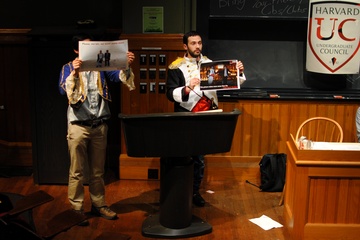If you, like us, were utterly confused by the recent e-mail blast ambiguously touting the arrival of Harvard’s “capital campaign” (or CapCam, as we like to call it), have no fear. We’ve read up on all things capital, from Das Kapital to the U.S. Capitol in search of what you need to know to impress even your economics concentrating blockmates. Here are the six things to know about Harvard’s capital campaign.
1. This is Harvard’s largest-ever fundraiser.
Harvard’s last capital campaign, completed in 1999, raised $2.6 billion. Years and a couple presidents later, Harvard’s back and ready to bring in more than double that: the new goal is a cool $6.5 billion—no cheap thrills to be found in Cambridge. Where will it come from? A certain illustrious individual with the initials W.(“B.”)G. was seen on campus promoting the campaign last weekend; however, the capital campaign will not in fact be funded by computer operating system profits. Harvard will be tapping alumni of all stripes willing to contribute funds that will be funneled into expanding the School of Engineering and Applied Sciences, increasing the school’s reach via EdX and other initiatives as close as the Allston campus. Financial aid, the humanities, and faculty resources are other realms prioritized by the campaign, which officially breaks down to 45 percent teaching and research, 25 percent financial aid and the “student experience,” 20 percent capital improvements, and 10 percent flexible funding to foster collaborations and initiatives.
2. President Faust challenges Harvard to challenge Harvard.
A key part of the launch of the capital campaign was President Faust’s speech on the subject, entitled “To Seize an Impatient Future.” In it, she enumerated Harvard’s storied past, listing achievements, alumni, and the responsibilities to continue Harvard’s legacy into the future. Rather than providing details, President Faust raised more questions, challenging her audience and the wider Harvard community to consider what we stand for. “What institutional commitments will we make to define who we are and who we will be decades and centuries from now? … What is it that Harvard could be? What will we do to make it so?” she asked. With CapCam’s end-game slated for 2018, it seems that only time will tell.
3. A student center is in the works.
If you’re wondering just how much the “student experience” is worth at Harvard, your answer is, combined with financial aid costs, exactly $1.625 billion, according to a fundraiser breakdown that was released to the Boston Globe last week. Just how that money will be spent is as of yet unclear; rumors of a new student center in Holyoke have been spreading, with confirmation only that a new student center is indeed in the budget, according to a Crimson article published September 13. Undergraduate Council Vice President Jen Q.Y. Zhu ’14, also a co-author of the UC report “The Case for a Harvard Student Center,” wrote in an e-mail that the student center-to-be “will significantly contribute to bringing together the Harvard community. It'll satisfy a need for not only more social space but more and different kinds of social interactions for students on campus.” Here’s hoping she’s right, and that it’s worth the hype, bringing “programming and other things to bring people to this central space for genuine and spontaneous interactions,” as Zhu says.
4. Research is still the priority.
Lest anyone forget that Harvard is a research institution (did you forget?), 45 percent of the money raised will be allocated for teaching and research. While those affiliated with the campaign contend that undergraduate teaching will be improved, most of the statistics released have been research oriented. According to the Boston Globe, the campaign will include “new construction and [renovation of] existing buildings for research facilities, the expansion of current research in fields ranging from the stems cells to the environment,” and the development of a “fledgling program to produce low-cost energy in developing countries.” Despite these ambitious projects, Harvard Provost Alan Garber insisted to the Associated Press that Harvard is “not trying to create another version of MIT.” With such lofty, research-oriented goals for an allocation of $29.25 billion, it is yet to be determined what portion of these funds will be used towards improving undergraduate education.
5. There is no end in sight for housing renovations.
Between the new-old, the old-new and the old-old, housing at Harvard has become even more confusing than usual. So which of the dozen adjacent, identical red-brick buildings do you live in again? Postmodern Quincy? It seems we’ll have to put up with Stone Hall-type nonsense for the foreseeable future, as money raised in the capital campaign will continue to fund House renovations. Who’s next? We’re waiting on the edge of our seats, or should I say bunk beds, Winthrop?
6. We’re almost halfway there.
While $6.5 billion is the official goal of the capital campaign, $2.8 billion has already been raised and some of that has already been spent. This money, raised quietly over the past two years through various gifts and pledges, has purportedly gone towards beginning the 10-year construction plan (1.4 million square feet!) that includes both the renovation of student housing and the expansion of Harvard’s research facilities. Further details on how the money has already been spent, and where the rest will go, have yet to be released, despite multiple interview requests with Campaign associates.



